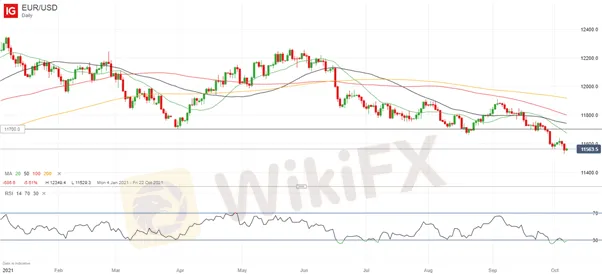简体中文
繁體中文
English
Pусский
日本語
ภาษาไทย
Tiếng Việt
Bahasa Indonesia
Español
हिन्दी
Filippiiniläinen
Français
Deutsch
Português
Türkçe
한국어
العربية
EUR/USD Forecast: What's the Incentive to Buy the Euro?
Abstract:Anyone thinking of going long the Euro needs to ask a simple question: what could be a catalyst for a change of direction? For sure, EUR/USD has already fallen steeply over the past month but the bad news for the bulls keeps on coming.
EURO PRICE IN DANGER OF FURTHER LOSSES
EUR/USD has been falling steeply for the past month now, dropping from a recent high just above 1.19 on September 3 to its current levels around 1.1550. Indeed, at one stage last week the pair reached its weakest point since July 2020.
Against this background, it could be seen as “cheap” enough to attract some dip-buyers and bottom-fishers, but where is the catalyst for a change in direction? The problem for Euro devotees is that the European Central Bank remains near the back of the queue of central banks thinking of tapering their monetary stimulus programs and, until it nears the front, the Euro will likely remain weak.
EUR/USD PRICE CHART, DAILY TIMEFRAME (JANUARY 4 – OCTOBER 7, 2021)

There were certainly signs last week of an improvement in market sentiment as the chances of an agreement on the US debt ceiling improved, Russian President Vladimir Putin rode to the rescue of natural gas buyers and news filtered out of a possible meeting between US President Joe Biden and Chinese President Xi Jinping.
However, the latest statistics from Germany, the Eurozones largest economy, were dire. Factory orders fell 7.7% month/month in August, far worse than the 2.1% forecast, and industrial production dropped by 4.0% when a 0.4% decline had been predicted. It was no surprise therefore that traders willing to inch out of the safe-haven US Dollar found other currencies more attractive than Euros.
Moreover, Bloomberg reported that the ECB is studying a new bond-buying program to prevent any market turmoil when its pandemic emergency support purchases are phased out next year. So not only is the ECB near the end of the queue, it seems to be leaving it; and thats bad news for the Euro.
WEEK AHEAD: ZEW
Turning to the economic data to be released in the week ahead, the only number of note is the ZEW index of German economic sentiment due Tuesday. Also on the calendar are final figures for German inflation in September and Eurozone industrial production in August Wednesday, and Eurozone trade data for August Friday.
Disclaimer:
The views in this article only represent the author's personal views, and do not constitute investment advice on this platform. This platform does not guarantee the accuracy, completeness and timeliness of the information in the article, and will not be liable for any loss caused by the use of or reliance on the information in the article.
WikiFX Broker
Latest News
Good News Malaysia: Ready for 5% GDP Growth in 2025!
How to Automate Forex and Crypto Trading for Better Profits
Is the stronger dollar a threat to oil prices?
Rising Risk of Japan Intervening in the Yen's Exchange Rate
Standard Chartered Secures EU Crypto License in Luxembourg
How Far Will the Bond Market Decline?
U.S. to Auction $6.5 Billion in Bitcoin in 2025
Trading Lessons Inspired by Squid Game
Is Infinox a Safe Broker?
How Did the Dollar Become the "Dominant Currency"?
Currency Calculator







